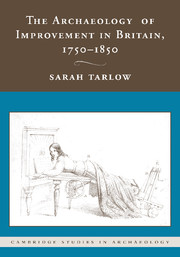THREE - THE IMPROVED RURAL LANDSCAPE
Published online by Cambridge University Press: 23 July 2009
Summary
In the previous chapter we saw how a belief in Improvement affected agricultural production in Britain; this chapter considers the closely related issue of how changes to the appearance of the rural landscape were brought about through a concern with economic, aesthetic and human Improvement. We have seen already that the ethic of Improvement incorporated economic, moral, religious and philosophical aspects. There was also a strong ‘improved’ aesthetic in later historical Britain. Its characteristics were cleanliness, order, rational organisation, light and clarity. It demonstrated the ownership of rational knowledge and taste, a general orientation towards the future and a selective rewriting of the historical and classical past. The improved aesthetic was particularly influential in shaping the towns of the periods and forming strategies for the Improvement of the poor and deviant, as we shall discuss in Chapters Four and Five. The rural landscape was also a product of the aesthetic of Improvement, although landowners at the time would not have recognised a distinction between aesthetic, economic and moral improvement. Aesthetic and economic improvement of the landscape carried out at this time had a positive moral value. This chapter considers the new aesthetic landscape, particularly through the consideration of the Hafod estate in Wales. Finally the archaeology of the Scottish highlands in the late eighteenth and early nineteenth centuries will be discussed as a manifestation of the ethic of Improvement.
- Type
- Chapter
- Information
- The Archaeology of Improvement in Britain, 1750–1850 , pp. 67 - 89Publisher: Cambridge University PressPrint publication year: 2007

